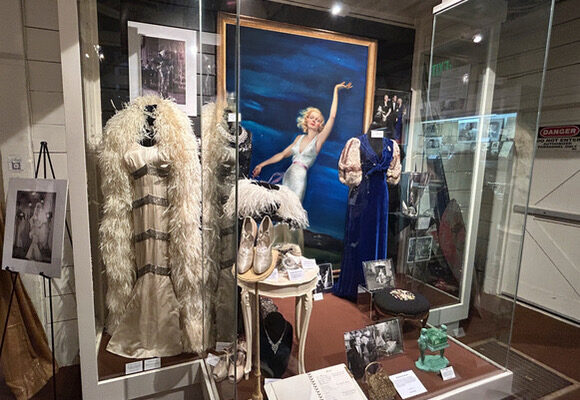“It is the only place in the world that grounds Marilyn’s myth into history, and the U.S. and world’s history. It is the only physical reminder that remains of (her) life and death. Marilyn has become part of our… collective unconscious.”
By ASHLEY CHASE
Did an emotional plea calling Marilyn Monroe a “sacred figure” from a Parisian art historian help convince city officials of the importance of preserving the former Brentwood home of Marilyn Monroe and recommending it be designated a historic-cultural monument after it was almost demolished last year at the request of the property owner?
Marilyn’s persona has grown into something much bigger than what she herself was — for multiple reasons — and has “attained the status of a sacred figure,” said French art historian Jacques Le Roux in an email urging for the city to formally act and declare the home a landmark.
“It is the only place in the world that grounds Marilyn’s myth into history, and the U.S. and world’s history,” Le Roux wrote. “It is the only physical reminder that remains of the life and death of an extraordinary human being. Marilyn has become part of our — the U.S. and the world’s — collective unconscious.”
“Destroying the only place she owned while alive, and where her transition into a sacred figure started would be a shame, and an irreparable error and ignorant act against culture and history.”
Monroe’s Spanish Colonial Revival home, hidden in a cul-de-sac at 12305 W. 5th Helena Drive, was the only home the Hollywood icon ever purchased herself. It’s also the home where she tragically died at the age of 36 in 1962, just six months after moving in.
Marilyn bought the house on the suggestion of her psychiatrist, who said the actress should “put down some roots.”
But in the short time she lived there, the house became an extension of herself.
“Anybody who likes my house, I am sure I will get along with,” she said in her final interview with LIFE Magazine of her distinctive one-story house with architectural charm featuring a red-tile roof and adobe walls.
As if to emphasize how she felt about her house, a tile next to the front door displayed the Latin phrase, “Cursum Perficio” — “Here ends my journey.”
Thick gates blocked the house off from the street. A curved driveway led to the front door, which opened into a wide living room with terracotta floors. Beams of wood lined the ceiling, and a blue-tiled fireplace anchored the room.
But the house’s future isn’t entirely secured. Monroe purchased the 2,624 sq. ft. hacienda for $77,500 in February 1962.
The city’s designation as a Historic-Cultural Monument “does not guarantee that the property cannot be demolished,” but it does allow the Commission to delay demolition for 180 days while other opportunities for preservation are determined.
The next step in saving the property is a review of the nomination by the L.A. Planning and Use Committee and then the LA City Council.
The designation of the home as a historic site also does not preclude the idea that the home could at some point be relocated to a more central location — one more easily viewable by the public than the current neighborhood in which it sits. Relocation would be a lengthy and costly process, however, and it remains unclear if the home would be able to be relocated.
The property was facing the possibility of destruction after the Department of Building and Safety issued a demolition permit to its current owner, Glory of the Snow Trust on Sept. 5. Days after it was issued, the L.A. City Council meeting unanimously voted to temporarily suspend said permit amid public outcry.
L.A.’s Office of Historic Resources performed various assessments in the weeks following the issuance of the permit to recommend that Monroe’s Spanish-style abode be permanently protected and designated a historic site.
Scott Fortner, a historian, collector, and host of the “All Things Marilyn” podcast, has been credited was playing a major role in saving the house as part of the Monroe Preservation Group, which he said has “worked tirelessly for months researching and documenting the history of Marilyn Monroe’s former and final home.”
“Our efforts and research, which was shared with today’s deciding body, concluded that famed historic Los Angeles architect Harbin Hunter not only lived at the home, but he also very likely designed it,” said Fortner. “The evidence lies in the famous tiles at the front door of the house, which read, ‘Cursum Perficio,’ the Hunter family motto.
“Our group, which consists of authors April VeVea, Gary Vitacco-Robles and Elisa Jordan, film producer and director Remi Gangarossa, and historians Kelly Lacroix and I, are thrilled to have participated in the process to have Marilyn’s home be recommended for a Historic Cultural Monument designation by the Los Angeles Cultural Heritage Commission today.”
The stucco home was built in 1929 and features four bedrooms, three baths, beamed ceilings, a grassy courtyard, gardens, a swimming pool, and more. A presentation delivered ahead of the vote explained how, in her short time living there, Monroe spent roughly $51,000 refurbishing and renovating the home. When adjusted for inflation, that comes out to more than $500,000.”
Last week the five-member Cultural Heritage Commission voted unanimously to prevent demolition efforts of the iconic movie star’s final home.
Barry Milofsky, the commission’s president, said that while Monroe’s home should be preserved, efforts to do so should not wait until demolition is pending.
During the meeting, attorney George Mihlsten, representing the property owner, Glory of the Snow LLC, argued the home should not fall under the city’s landmark ordinance, citing that the home had been empty and bare, and not worthy of being a monument.
Additionally, they argued the home was not in the public right of way. Sahure also noted that Monroe’s home would increase tour bus traffic and disrupt peace in the neighborhood.
Heather Goers, the preparer representing the city of Los Angeles in its efforts to protect the home, countered that first argument that Monroe was waiting for custom furnishing for her home when she died, and even registered her dog’s license in the city.
Adrian Scott Fine from the Los Angeles Conservancy was in attendance, supporting Monroe’s home being made a city landmark.
Kevin Deevey, who described himself as a Hollywood preservationist for many years, also wrote an email to the commission calling for the home’s protection. He said the house is part of an identity that is “being lost in Los Angeles,” focusing on the home’s architectural design.
“The property is zoned as a single-residential and has been there for nearly 95 years, having been originally built in 1929,” Deevey wrote. “It is a beautiful example of the Spanish Mission style homes which were so common in Los Angeles at the time it was built.”
The Los Angeles City Council’s Planning and Land Use Management Committee will take up the matter at a future date. The designation will then need to be approved and adopted by the full council before the home is considered a historic-cultural monument.
In response to the commission’s vote, Councilwoman Traci Park, who represents the 11th District, encompassing the coastal and West Los Angeles neighborhoods, including the location of Monroe’s home, said she was pleased with the outcome.
“This significant step brings us closer to safeguarding this historic landmark from demolition,” Park said. “Since initiating this process in September, our office has been steadfast in our commitment to historic preservation and remains dedicated to addressing community needs.”
Includes reporting from LA Independent news services and Genevieve Carlton for allthatsinteresting.com






katana